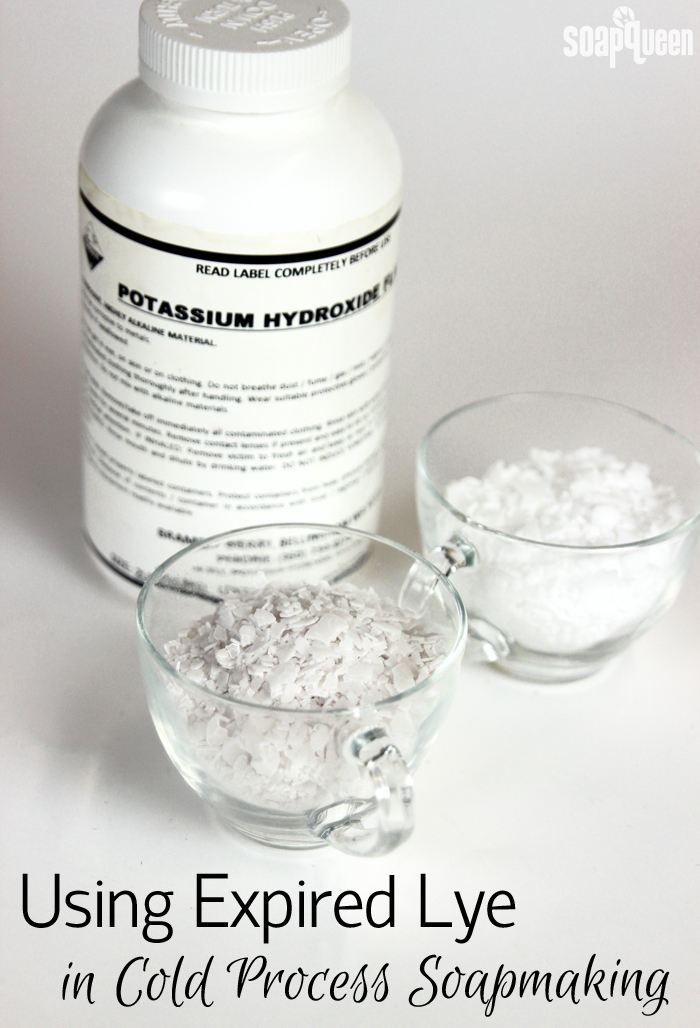
When troubleshooting a cold process soap recipe, there are several factors to look at. For instance, if your batch accelerated or riced, it may be the fragrance oil. If the batch is taking longer than usual to trace, it may be a high amount of soft oils, like olive oil, in the recipe. Another thing to investigate is your lye. If lye is past its prime, it can do some odd things in your soap.
Lye is an inorganic compound that is commonly found in drain cleaners. It is highly caustic and can burn the skin if not handled properly. Working with lye requires long sleeves and pants, close-toed shoes, a well-ventilated room, gloves and eye protection. Before handling lye, make sure to watch this Soap Queen TV video on lye safety. The Lye Safety Guide has more information on how to work with it. You need to be fully prepared and follow every safety precaution before getting started.
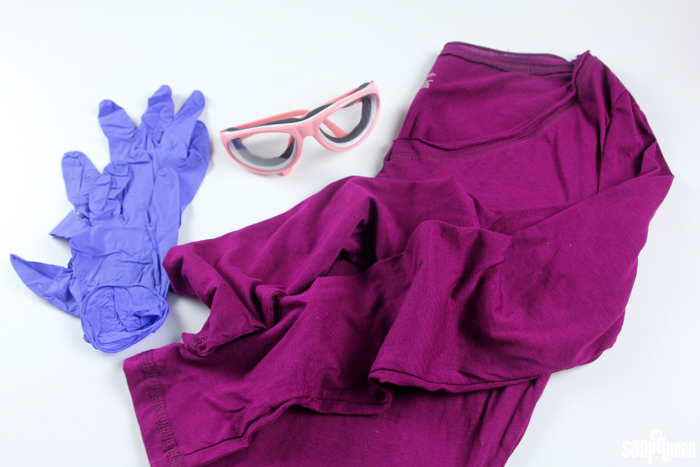 Working with lye requires safety gear like goggles, gloves and long-sleeved shirts and pants.
Working with lye requires safety gear like goggles, gloves and long-sleeved shirts and pants.
Lye is necessary for the soapmaking process. By definition, soap is a chemical reaction between oil and lye. This reaction is called saponification. During the saponification process, the lye gets used up. That means it is not present in the bars after they’re cured. Read more about saponification in the Where’s the Lye post.
For soapmaking, lye comes in two types. Sodium hydroxide lye is used to make solid cold process soap. Potassium hydroxide lye is used to make liquid soap. Read more about potassium hydroxide here. Both types of lye are dissolved in a liquid, like distilled water or milk. Make sure to always add the lye to the liquid, not the other way around. If the liquid is added to the lye it can cause a volcano-like reaction. You can use our Lye Calculator to find out how much lye and liquid to add to your recipe.
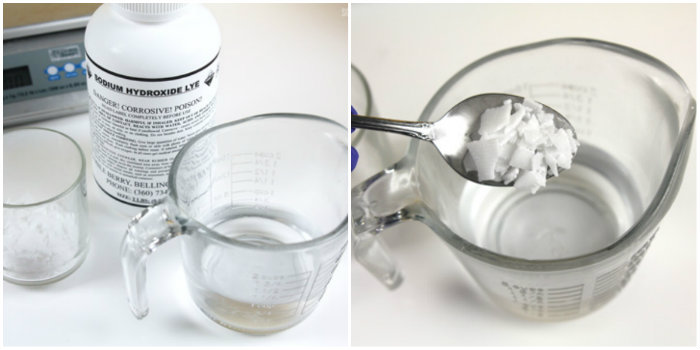 Sodium hydroxide lye is used to make solid soap, and potassium hydroxide lye is used to make liquid soap.
Sodium hydroxide lye is used to make solid soap, and potassium hydroxide lye is used to make liquid soap.
To ensure the lye works properly, we recommend using it within one year of purchasing. It needs to be sealed tightly and stored in a dry place. Lye is hygroscopic, meaning it attracts moisture. If it’s exposed to moisture in the air it won’t be as effective in your recipe, and the soap may not saponify fully. The lye also needs to be kept in a cool place. It may lose its potency if stored in warmer temperatures. In the Soap Queen Lab, the lye is double sealed and stored in a box that is placed on a shelf. At home you can store it in a cupboard, in your garage, etc. Just make sure it’s clearly marked and out of reach of children.
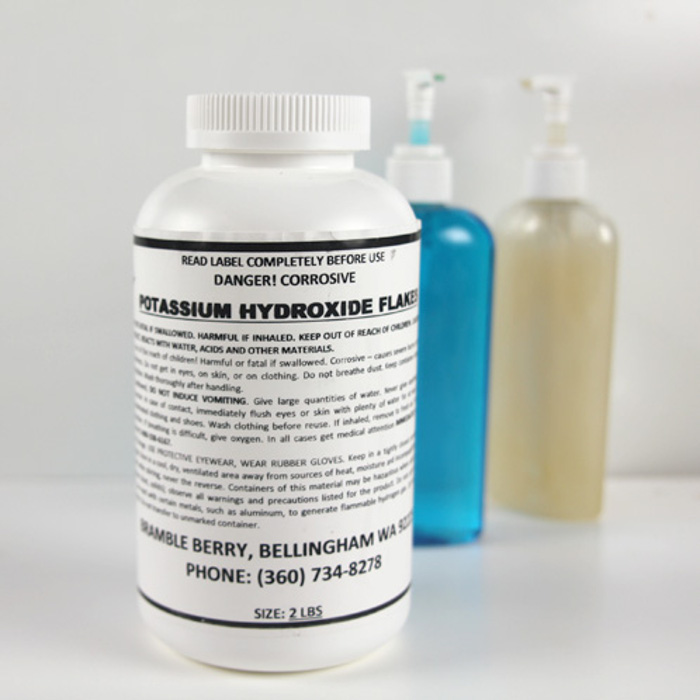 Make sure to store your lye in a cool, dry place to extend the shelf life.
Make sure to store your lye in a cool, dry place to extend the shelf life.
How can you tell if the lye is expired? The first clue is how it looks. Check out the photo below. The expired lye on the left is more of a gray, off-white color than the lye on the right. It is also clumping in several spots because it has absorbed moisture from the air.
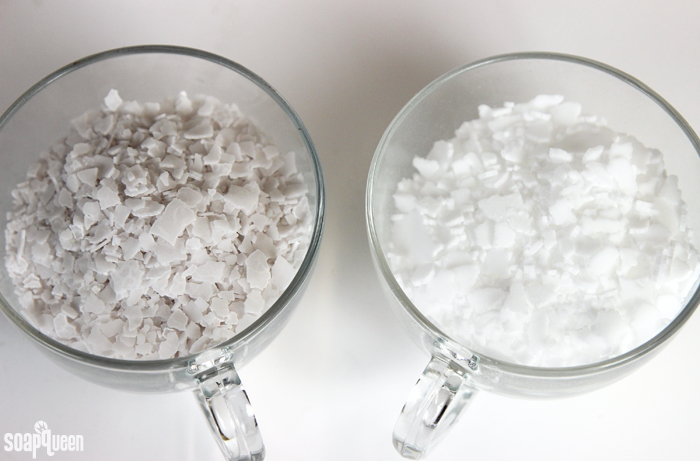 Above, the expired lye is shown on the left and the fresh lye is shown on the right. Notice the color difference!
Above, the expired lye is shown on the left and the fresh lye is shown on the right. Notice the color difference!
Another clue the lye is expired is how it acts when added to water. When lye is added to distilled water, it gets really hot – up to 200 ° F. Expired lye won’t get nearly as hot. Below, we added 2 ounces of fresh potassium hydroxide lye to 5.3 ounces of distilled water. The fresh lye was about 141 ° F when it was added to the water and stirred to dissolve. The expired potassium hydroxide lye only reached about 124 ° F. It also had a slightly cloudy appearance, even after thorough stirring.
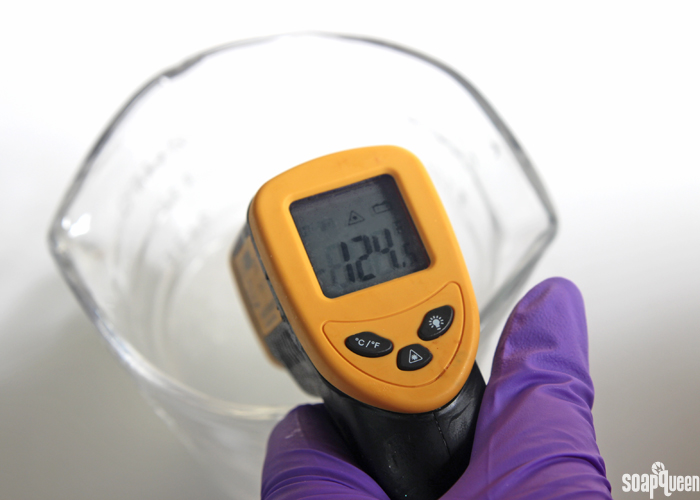 If your lye solution does not get very hot, it may be expired. Above, the potassium hydroxide lye solution using expired lye only reached 124 ° F.
If your lye solution does not get very hot, it may be expired. Above, the potassium hydroxide lye solution using expired lye only reached 124 ° F.
If you notice anything odd happening with your lye, don’t use it in cold process soap. Expired lye doesn’t saponify properly, meaning your soap may not reach trace. Read more about trace in this post. This can also happen if you accidentally use potassium hydroxide lye in a solid cold process recipe. Make sure to check the label before adding it to your batch. If the soap does trace, it may not set up properly and can be soft or sticky to the touch.
 Using expired lye can mean your soap won’t reach trace.
Using expired lye can mean your soap won’t reach trace.
To avoid any wasted soap, make sure to keep your lye tightly sealed in a cool, dry place. We like to mark all of our bottles in the Soap Lab with the date it is opened. That way we can replace the lye after a year to prevent it from going bad. If you used expired lye in your soap and the soap set up, great! The soap is fine to use, albeit a little extra superfatted. If you used expired lye in your soap and your soap did not set up, there is no way to save the soap because we don’t know exactly how much lye it is short. To dispose of the lye, you can mix it with distilled water and pour it down the drain. Lye is actually found in most drain cleaners. If you’re worried about your drain, you can also contact your local waste management services to find out how to dispose of hazardous materials.
How do you store your lye to ensure it stays fresh? Have you ever used expired lye in your soap before?





i mixed some lyes last week, and ran out of “soaping” time! =O how is itgood for??
As long as that lye is in a sealed container, it is good for a long time. The sealed container prevents any evaporation. We do find sometimes when we prep lye ahead of time it forms chunks on the top. We’re not quite sure what those are, but to be extra careful we like to pour the lye and water through a strainer into the oils.
-Kelsey with Bramble Berry
Kelsey my question is, is lye that has clumps safe to use. I was worried about it exploding if it had absorbed any moisture. Mine has some large chunky areas on the top. I can break it with a wooden spoon or something but wanted to make sure it is safe to do that. Any thoughts? Jan
How old is your lye? Typically when it clumps up like that it means it absorbed moisture and may not be as effective as fresh lye.
My soaps are seeming to all turn out lye heavy – even though I run them through the lye calculator and follow the recipe carefully. Any idea why that’s happening and what I can do about it? Thanks!
You may check your scale and calibrate it! If it’s off, it can create lye heavy soap. It can also be caused if the soap isn’t quite reaching trace. That can cause separation that creates lye pockets. Learn more about trace here: http://www.soapqueen.com/bath-and-body-tutorials/tips-and-tricks/trace/
This post has more on causes for lye heavy soap: https://www.soapqueen.com/bath-and-body-tutorials/tips-and-tricks/troubleshooting-lye-heavy-soap/
-Kelsey with Bramble Berry
I make a CP lye soap for my own use from used fry oil (think turkey frying once a year) so as not to pollute, waste, or clog my drains. As I usually only do this once a year, and even a small container of lye is more than enough, I am always using “old” lye, and it is stored in a hot and humid garage. The granular lye is always white, but sometimes has clumps that are easily broken up; this means that some moisture has been adsorbed by the lye, which will alter the weight and activity of the lye. To compensate for the additional water weight and supposed reduced potency of the lye, I usually add about 2-3% extra of the “moist” lye to the normal amount of water. The soap I make never traces, but it does change color and thickens; I pour the mix into a loaf pan anyway and wait. What happens is that a clear sweet tasting liquid separates on the top after a few days and leaves the more solid soap on the bottom. I usually let this pan sit for about 2 weeks, drain the remaining top liquid off, remove the soap, slice and dry. Makes fairly long-lasting shower soap, but a bit lye heavy. Even a “bad” batch may turn out OK if you just have patience….
Glad you found a method that works great for you! We find using fresh lye makes the process easier. Also, lye heavy soap can irritate the skin, so we recommend using the measurements on our Lye Calculator: https://www.brambleberry.com/Pages/Lye-Calculator.aspx
-Kelsey with Bramble Berry
Humberto, is the clear liquid on top not perhaps glicerine?…. slightly thicker than water?…. remember you dont ADD glycerine to make glycerine soap, you just dont remove it… perhaps off-ish lye and (salty) turkey fat dont GEL so well and glicerine seperates from the mixture…. as far as i understand adding salt to the mixture can do this
So I clearly was over excited about soap making and purchased too much lye but they packaged it in separate 2lb bottles that have not been opened the expiration on them says 6/20/2016 so if they aren’t open and warm up nice they are ok to use? They seem really white and they have remained indoors. So are you saying when I open it then its good up to a year? I bought them a year ago. Thanks in advance!
Hi Deedrah!
If they didn’t absorb moisture from the air they should be fine to use! To be extra careful, I would recommend making a small test batch with the lye. Watch to see if the lye doesn’t heat up, or if the batch is really slow to trace and turns soft. That way you can see if it works before making a larger batch. 🙂
-Kelsey with Bramble Berry
I did the same thing, not knowing it would expire before using. I found that was impossible to get the temperature of my lye/milk above 76 degrees. Even tightly covered, lye starts to absorb moisture and will still react by resulting in low temp mixture. The only way to resolve this and not waste lye was to place my lye mixture in a “hot” water bath, using hot water from the faucet to bring it within 10 degrees of my oils.
do you make your own lye at bramble berry
Hi John!
We do not, we get our lye from a vendor. We have tried making our own lye in the past, but it’s pretty labor intensive! If you have any other questions, let me know. 🙂
-Kelsey with Bramble Berry
My 50 gallon container of lye was made of cardboard. It absorbed moisture, and I discovered I had a lot of rock-hard chunks, along with the granular. Are the chunks usable? Will they weigh accurately?
The reason I ask is that I just made what turned out to be a lye-heavy batch, and I’m trying to discern if it was human error in measuring the lye, or if the chunks are to blame. In the meantime, I’m making laundry soap, thanks to you!
Hi Mary!
Even if the lye is in chunks, it should weigh the same as the loose lye. Because of that I think they should weigh accurately! My worry is that because the lye has chunks, the moisture may make it less potent. How long ago did you get the batch? Thanks Mary!
-Kelsey with Bramble Berry
hi I made soap two weeks ago with some lye that I had there for some months now, to my surprise and for the first time my batch of soap I put it in a silicone mold and left it there for 48 hours and when I check on it ,it was soft and sticky and could not come out of the mold, so I was wondering what was the problem, was it the lye, the silicone mold or the scale because when I use the scale it was not all that accurate .the soap did not gelled properly and is still soft should I throw it away?
Hi Natalie!
It may be a number of factors! For instance, if your recipe is on the softer side, it will take longer to harden. What ingredients did you use? What temperatures did you soap at? Let me know and we’ll figure this out. 🙂
-Kelsey with Bramble Berry
I’m really surprised by the low temperatures you listed…(141 F for good lye, 124 F for bad)…they seem really low. (Any feed back from others out there? Is this the temp your good lye gets?)
When I use lye it always gets up to 200-210 F. (I live near Denver, CO where everything cooks/boils at a lower temperature due to the altitude, so I would expect a lower temperature than everyone else gets at sea level.)
The one time I have had trouble with lye was on the second soaping class I took. The lye only reached 156 F and when I stick blended, the soap never reached trace.
Thank you for all this interesting information!
Sly
The example listed referred to potassium hydroxide vs. sodium hydroxide, I don’t know if potassium hydroxide naturally has lower temps or not. As far as I’ve paid attention, the lye (sodium hydroxide) I get from Bramble Berry heats up to around 165F, I’ve never used lye that went to 200F.
Hi Sly!
How hot the lye gets depends on a couple of factors, including the temperature of your water, the temperature of your house, etc. I’ve also noticed potassium hydroxide seems to get a bit cooler than sodium hydroxide. I would recommend taking the temperature of your lye each time you make it. That way you know roughly how hot it gets each time. If you notice a large drop in that temperature, it may be expired and need to be checked. 🙂
I wanted to let you know I removed part of your comment about the lye from another vendor. We like to promote a positive environment on our blog, and felt it was best to remove that section. If you have any questions about another vendor’s products, make sure to contact them. If you have any questions about our lye or other products, definitely let us know. We’re happy to help!
-Kelsey with Bramble Berry
No worries Kelsey….someone else had commented on that vendor’s product in this blog post, so I wanted to give them my feedback on the experience I had with that lye.
I always measure the temperature of my lye (sodium hydroxide), which is why I noticed a 10 degree drop with the other vendor’s lye and why I noticed my soap reaching a thick trace really quickly… And the reason I questioned if it was old lye and requested feedback from other soapers, (which was all removed from my comments).
Thank you Michael for the clarification…
I didn’t realize in the paragraph that started out with talking about sodium hydroxide reaching close to 200 degrees, that the next sentence switched to talking about the temperatures of new potassium hydroxide vs expired/old potassium hydroxide. Good catch!
Very confusing to talk about Lye (without stating sodium hydroxide) in one sentence and continuing the rest of the paragraph talking about potassium hydroxide (a lye that I bet most of the readers don’t use)…no wonder I got the two confused.
Thanks for all the feedback!
Hi Sly!
Both potassium and sodium hydroxide can get up to 200F! It depends on the liquid you’re using, the lye you’re using, etc. For instance, if you add potassium hydroxide lye to warm coffee, it can get quite hot. We like to put up to 200F to show how high it can potentially get. In my experiences with potassium hydroxide and sodium hydroxide I have noticed potassium gets a bit cooler, but that will vary! I’m sorry for any confusion. Thank you so much for your feedback. 🙂
-Kelsey with Bramble Berry
Kelsey:
Thanks so much for clarifying that!
You’re welcome! If you have any other questions let me know. 🙂
-Kelsey with Bramble Berry
I used to order lye in 100 lb. kegs in Hawaii (on the rainy side of Hawaii Island) I did not know at that time that lye would suck water out of the air. I ruined at least 50 lbs. by not knowing that. After that first disaster I put desiccant packets in the top headspace of my lye keg after I opened it and tried to seal it up tight after every use. Yes, it really can go bad!
I was told to mix it with 2 X water and let it cool and then mix with equal vinegar and let it cool before putting any large quantities down the drain. Smaller quantities are ok with just water, but only once in a while.
Thank you for this article.
You’re welcome Lauri! Thank you so much for your tips. They’re really helpful, especially for people in humid climates. 🙂
-Kelsey with Bramble Berry
I am using lye I purchased at least 12-13 yrs. ago. I have never had any issue with it and had never heard of it expiring. I bought 10# at the time and probably still have at least 4-5#. I will never waste it as that would be stupid for me to do here, so will continue to use it. It is still like it was when I bought it and is white in color. It gets to about 135* or so so I guess it is fine to use. Just want others to know it is NOT necessary to toss something because it is over 1 year old. I have made many batches of soap from this and never an issue. How does one know how old it is when you purchase it anyway. I enjoy making, using, and selling my soap. I make mostly small batches of soap using herbs, flowers, etc., that I grow organically on my homestead. I enjoyed reading this but sad to hear all the problems with older lye when I have had none. I will continue to use the same lye until it is gone. Then will buy a large quantity like before. Mine is in the original container with a very tight fitting lid. The temperature ranges from 50*-90* as it is in the house in an unheated and uncooled room. Thanks for all the info.
I do not wear gloves, jeans, shoes, or long sleeves when making soap but you should do as recommended. I can see no reason to wear shoes. I never wear shoes in the house ever anyway. I do not add any colorants of any kind as I like to keep the price down. I sue my stand mixer to make soap as hand blenders are not recommended for long , constant use. Since I have it no need to purchase anything else. I take a piece of cardboard and cut to fit around the beaters and use duct tape to keep it in place and no splatters ever. I sue a reg. thermometer, have never used a digital one as I would have to purchase it. Until the last couple years I didn’t even use a digital scales for weighing my ingredients. The old reg. scales worked fine, but it is easier with the digital one. I use big spatulas to stir my lye and oils from Gordon Food Store. I keep them just for soapmaking and they’re great. I use only real essential oils not fragrance oils as they’re better and have useful qualities to them. Cider soap with thyme dried herbs is a favorite, as is cinnamon, they both only have EO’s in them.
Hi Deb!
Thanks so much for your comment! We recommend using that lye within a year. As it sits, it can absorb moisture and become less effective in the soap. So, while the soap may trace, it can take longer, or it can separate afterward. We definitely recommend using a fresh batch!
Also, we strongly recommend wearing safety gear when working with lye. I have gotten fresh soap on my arm where a little skin was peeking through and I can tell you it does not feel pleasant! It may even burn the skin. For anyone working with lye, we recommend being safe and wearing gloves, long sleeves and pants, close toed shoes and goggles. Get more lye safety tips in this post: https://www.youtube.com/watch?v=yR6ttCSrLJI
-Kelsey with Bramble Berry
I have been master batching my lye solution for over a year now and never had a problem until recently. I had to separate incidences where after I mixed up my solution used what I needed that day, I poured the lye solution into storage containers after it cooled a little. Then when I went back the next day or two, the solution had crystalized. Parts were still liquid but parts were all clumpy. I obviously did not use but am wondering what happened. Any ideas?
We have had that happen to us when we make lye the day before! We notice some crystals on top, even when it’s wrapped with plastic. I am not entirely sure what’s happening. My only guess is that the lye may be separating slightly as it sits at room temperature, but I’m not sure if that’s the case. To be extra careful, we like to pour the lye through a strainer to catch the crystals in case they’re undissolved lye. 🙂
-Kelsey with Bramble Berry
After years of soapmaking, I had an interesting experience with lye the other day. Either the plastic container or myself must have gained a static charge and when I opened it, small lye particles literally were jumping out of the container! I tried to pour it quickly into the container, but it really turned into a disaster.
Oh my gosh, I hope you’re OK! That sounds like a scary experience. I did a quick internet search and it sounds like the lye has more static electricity when it’s humid, as it’s reacting with the water in the air. For your next soaping session, I would recommend a dehumidifier to dry the room out nicely. A couple soapers in humid areas also recommended giving the container a good shake before opening. We haven’t tried that trick, so if you do be careful when opening that jar. 🙂
-Kelsey with Bramble Berry
Next time you open your bottle, run a dryer sheet around the neck and inside of the lid, it helps control the crawlies a little. I usually try doing this after each use. (I have a dryer sheet that gets re-used just for soaping).
If you do the same thing with the container you’re pouring into before you pour, it will help keep things from crawling out, as well as making sure it pours cleanly and doesn’t leave anything in your measuring container.
I also recommend using a deep stainless steel bowl for measuring lye beads. It helps A LOT when it comes to static. In plastic bowls it flies everywhere!
Thanks for the great tips! 🙂
-Kelsey with Bramble Berry
I always manage to use mine up well before it is a year old, but this post is great! I did not know that it actually changed color like that, even though I knew to keep an eye out for clumping. You learn something new eveyrday! Thanks Soap Queen!
You’re welcome Margaret, glad you like the post! Thanks for reading and commenting. 🙂
-Kelsey with Bramble Berry
How do you dispose of expired lye???
Hi Terry!
We recommend mixing it with distilled water and pouring it down the drain, or if you’re worried about your pipes, you can contact your local waste management services to see how to dispose of hazardous materials. I went ahead and updated this post with that information! 🙂
-Kelsey with Bramble Berry
What would be the eight way to dispose expired lye?
I’m sorry, I meant “the right way”
You can mix it with distilled water and pour it down the drain. If you’re worried about your pipes, you can contact your local waste management services to see how to dispose of hazardous materials. I updated the post with that information to make it more clear! 🙂
-Kelsey with Bramble Berry
Do you have to use within a year of purchase, or within a year of opening to avoid expiration?
Hi Simone!
We recommend using the lye within a year of purchase. Even if the bottle is sealed, a tiny bit of moisture may want to sink in. Using it within a year of purchase will help ensure the lye works well in your batch. 🙂
-Kelsey with Bramble Berry
Thankfully Ive never had an issue with my lye. I store mine in the garage when its cool outside and in the basement in the summer. I buy small quantities (4 pounds at the most at a time).
Hi Mary!
That sounds like a great place to store your lye. Cool and dry areas are ideal. 🙂
I wanted to let you know I removed part of your comment about the lye from another vendor. We like to promote a positive environment on our blog, and felt it was best to remove that section. If you have any questions about another vendor’s products, make sure to contact them. If you have any questions about our lye or other products, definitely let us know. We’re happy to help!
-Kelsey with Bramble Berry
No matter what I do, my Lye, which comes in 1 lb bottles (kept cool/dark), seems to get weak after about 2 and a half months. Batches made with it are consistently lacking in bubbles & are really soft & oily. I have noticed this repeatedly over a 2 year period. As soon as I replace it, soaping goes back to normal. Next time I buy lye, I am going to try adding desiccant packets to the bottle & will also put it into a 2nd container.
I’m sorry about that Dee, that sounds really frustrating. Are you living in a fairly humid area? I think it would be OK to pop those desiccant packets inside. I would recommend double checking with the manufacturer just to be extra careful. 🙂
-Kelsey with Bramble Berry
I keep my lye in the original sealed packaging until I’m ready to use it and store it on a shelf in my hobby room – it is cool dark and dry in there. And I only buy it in safe and usable quantities, so there will not be any chance that it will go old. I assume that lye is fairly new/fresh when it is obtained from the source.
That’s awesome! Keeping that lye fresh will ensure that soap traces nicely. 🙂
-Kelsey with Bramble Berry